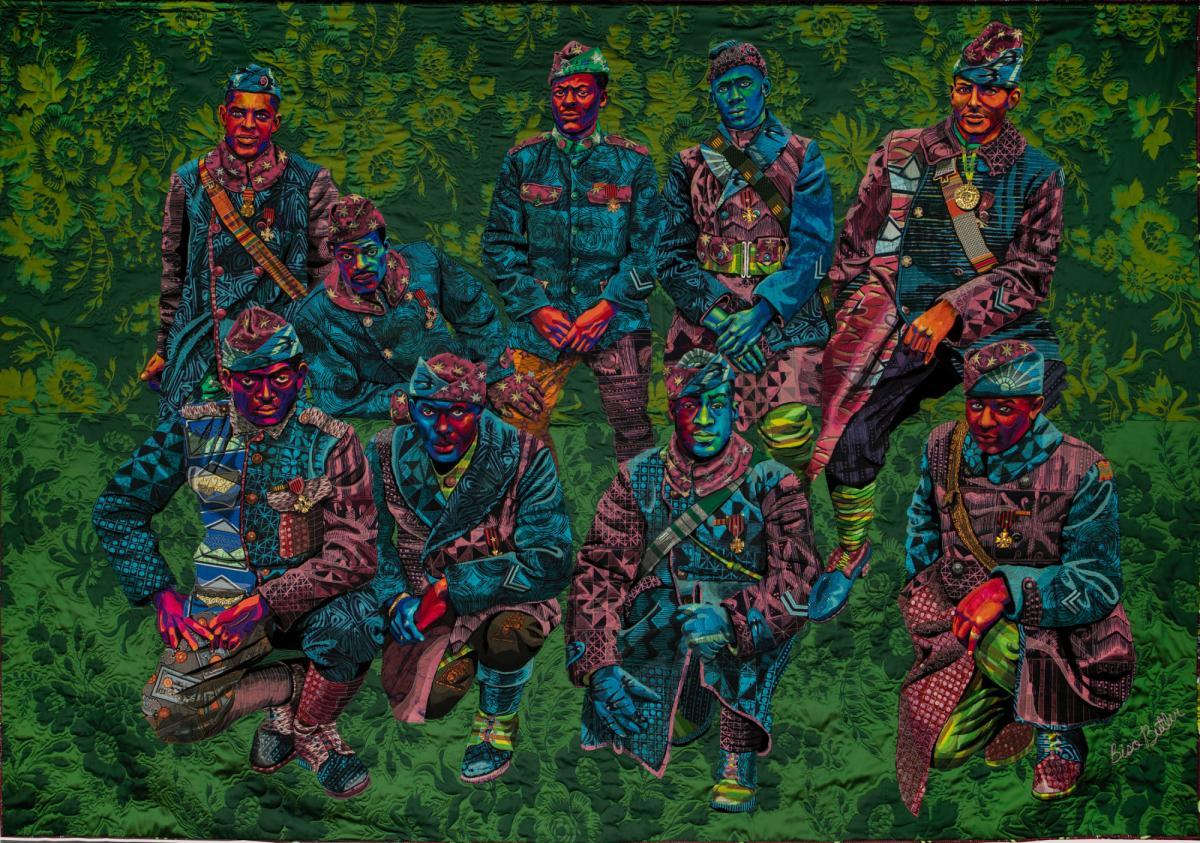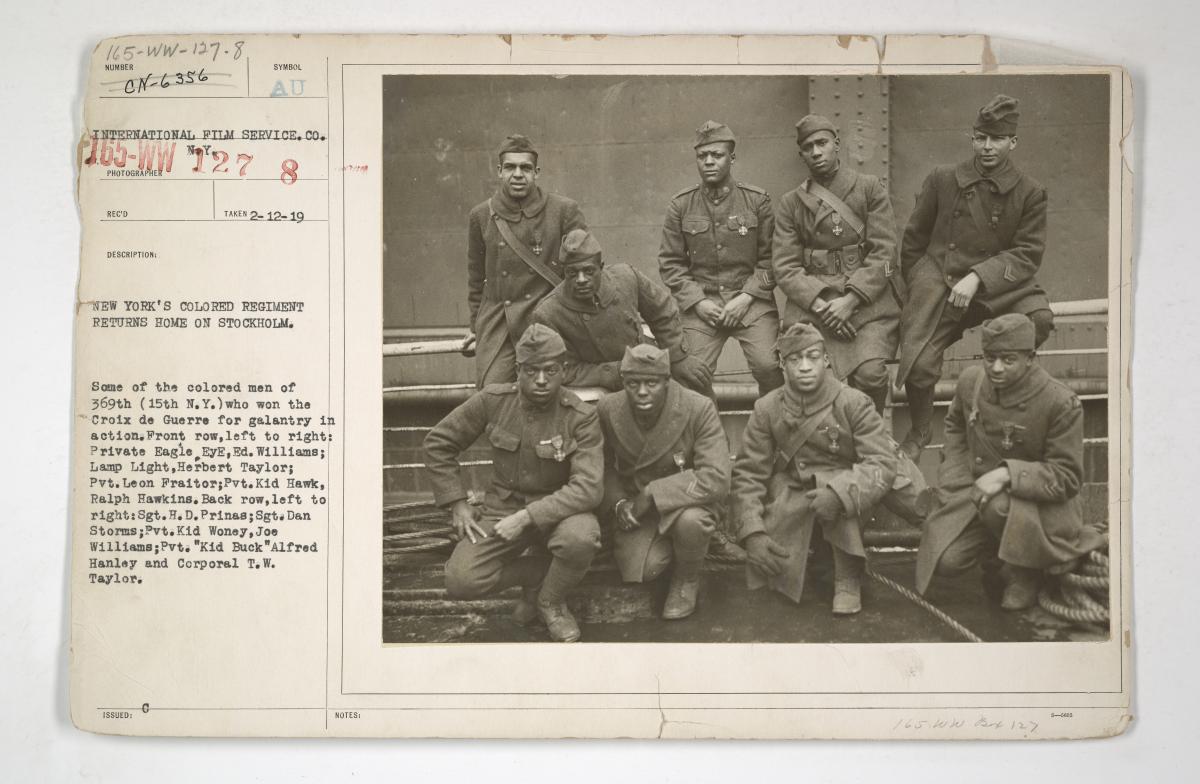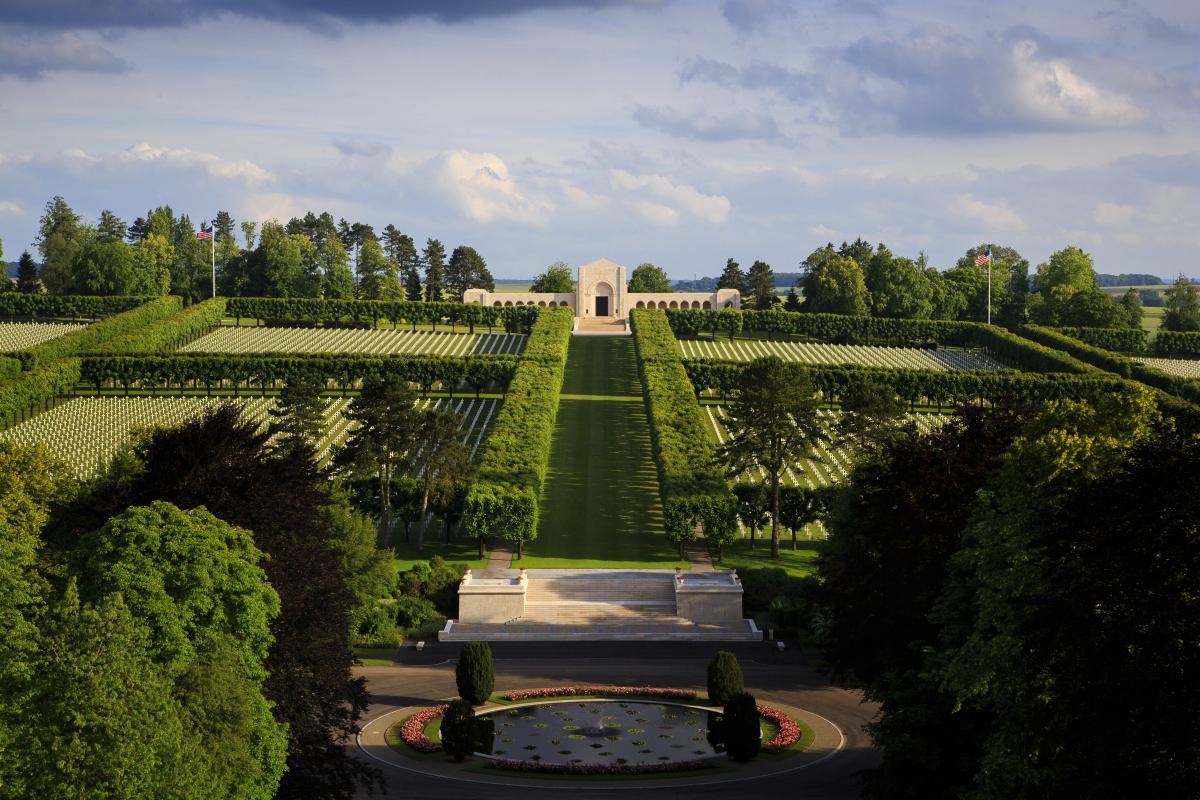
When educators cover U.S. military history, they may not immediately think of contemporary art as a teaching resource. But a 2021 artwork by artist Bisa Butler on display in the Smithsonian American Art Museum’s Renwick Gallery is tailor-made for sparking student inquiry into an essential chapter of World War I history. In advance of Memorial Day, we asked Benjamin Brands, a military historian at the American Battle Monuments Commission (ABMC) to tell us more about the hidden histories contained in Butler’s stunning quilt, Don’t Tread on Me, God Damn, Let’s Go – The Harlem Hellfighters. The Project Zero thinking routine Unveiling Stories, used to help students investigate layers of meaning in an image or text, frames our exploration of the artwork.
What is the human story?
What can we learn about the individuals depicted in this artwork, and their experiences?
Bisa Butler’s quilt is based on a famous photo in the National Archives of members of the 369th Infantry Regiment, as they returned from France following victory in World War I. Thanks to the photograph’s caption, we know the names of all nine men depicted. They are combat veterans, and each wears the Croix de Guerre, a French decoration for valor. Nicknamed the “Harlem Hellfighters,” the 369th was one of eight segregated African American infantry regiments that fought in France during the war. The Hellfighters spent more time on the front line — 191 days — and suffered more casualties — fifteen hundred — than any other American regiment.
In addition to these combat losses, the men of the 369th and other African American units faced discrimination from their own army. America in 1917 was at the height of Jim Crow, and the U.S. Army was rigidly segregated. As the Army swelled in size with draftees in the wake of the declaration of war, African Americans were largely assigned to segregated labor and stevedore (ship loading and unloading) units. However, many African Americans believed that front line service would demonstrate their capabilities and serve as an important demonstration of equality. The rights of citizenship had long been linked to military service, and African Americans looked to combat in France as an important step in furthering their rights and recognition at home. Two combat divisions, the 92nd and 93rd, composed of African Americans and largely led by white officers, were formed and were among the first units sent to France. Two of the regiments for these divisions were built around existing African American National Guard units, the 8th Illinois which became the 370th Infantry and the 15th New York which became the 369th Infantry.
What is the world story?
How does the Harlem Hellfighters’ story fit into a larger global context of World War I?
By the time of American entry into World War I in April 1917, the opposing sides had been fighting for almost three years at the cost of millions of lives. The entire U.S. Army numbered barely over 100,000 men, so raising and training a force for modern war meant that it was over a year later by the time American combat troops arrived at the front. By then Russia had left the war, freeing Germany to focus on the Western Front. French and British leaders, desperate for fresh troops, argued that American soldiers should be fed in small units into French and British armies where they could benefit from experienced Allied leaders. Called “amalgamation,” this policy was anathema to General John J. Pershing, commander of the American Expeditionary Forces, who was determined to field an independent American army. American leaders, however, were willing to make an exception. Not confident in their fighting ability and worried about conflicts with white troops, the Army sent both African American divisions to serve with the French. This meant that the 369th and the other African American regiments were among the first Americans to see combat, where they amply demonstrated their fighting spirit and skill, as shown by the Croix de Guerre worn by the men in Bisa Butler’s artwork.
What is the untold story?
How can this artwork help us access histories that have been overlooked or erased?
One of the reasons Bisa Butler’s quilt is so powerful is that it symbolically restores part of the identity of these soldiers. The history of the 369th was marked by heroism but also racism, even following their return to the U.S. One effect of that racism was to erase or delegitimize the identity of these men as Americans with rights and obligations equal to other Americans. There was also an element, during the war, of sublimation of individual identity into the corporate identity of the Army, a factor that impacted both white and Black soldiers. For the Hellfighters, this was particularly poignant. Raised as the 15th New York in 1913, the Hellfighters were proud of their regiment, which was an important symbol to the African Americans of New York City, and especially of the community of Harlem where the regiment was based. While a standard army policy of unit numbering, the redesignation of the regiment as the 369th Infantry was a profound loss for the members of the 15th New York as well as the community. Bisa Butler’s work reimagines these men in textiles and colors associated with African culture and the Black Power art movement, dissolving the uniformity bestowed by the Army. This echoes the cultural impact of the Hellfighters in their own time; the 369th’s band is credited with introducing jazz to Europe, while many members of the regiment returned to New York after the war and were central to the Harlem Renaissance.
One additional hidden story becomes apparent when viewing the source photo. While popularly known as the Harlem Hellfighters – a name bestowed, according to legend, by their German enemies but more probably by the American press – the name the regiment chose for itself was the “Black Rattlers.” They embodied this nickname in a regimental insignia depicting a rattlesnake, coiled and ready to strike. By Army policy, the men of the 369th should be wearing the patch of the 93rd Division (which depicts a Buffalo, in reference to the African American “Buffalo Soldiers” of the western frontier) but the distinctive rattler patch is visible on at least two of their uniforms in the source photo, a small but important symbol of their self-defined identity even in the face of segregation and Army uniformity.
Through close-looking at Butler’s quilt and a gradual layering in of historical context through the Unveiling Stories approach, students will discover the bravery, complexity, and humanity of these extraordinary men. While they faced discrimination from the country they fought for, in death they were treated equally. 169 members of the 369th Infantry are buried alongside their white and Black comrades, in the eight American Battle Monuments Commission World War I cemeteries, mostly at Meuse-Argonne American Cemetery in France. They are buried in perfectly aligned rows of marble headstones, with no segregation by race or separation by religion or rank.
The American Battle Monuments Commission (ABMC) is a federal agency dedicated to honoring the service and sacrifice of more than 200,000 U.S. service members buried and memorialized at its 26 cemeteries and 32 monuments and memorials in 17 countries, including the United States. A partnership between the Smithsonian American Art Museum and ABMC creates educational experiences to commemorate the honor, service, and sacrifice of America’s fallen in wars abroad. Visit our education page to learn more about SAAM's initiatives and resources.






















